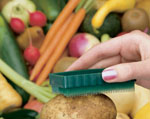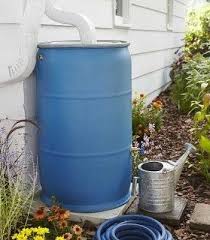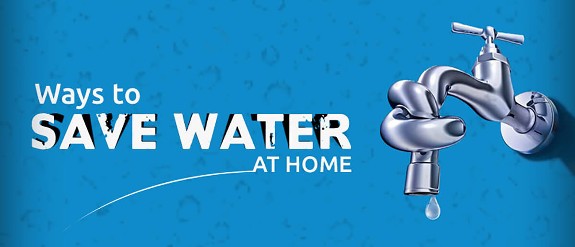With a possible change being investigated, in how West Easton residents should be charged for sewer billing, some residents who are high water users, will need to learn how to use less water. Should a change happen, sewer billing will be based on individual water meter readings, ending the past practice of equally dividing the entire community bill among all residents. It would become a, “pay-for-what-you-use” billing system.
Below are 26 ways to reduce the amount of utility supplied water used around your home.
 1. Check your toilet for leaks.
1. Check your toilet for leaks.
Put a few drops of food coloring in your toilet tank. If, without flushing, the coloring begins to appear in the bowl., you have a leak that may be wasting more than 100 gallons of water a day.
2. Stop using your toilet as an ashtray or wastebasket
Every flush of only cigarette butts or tissues also flushes away five to seven gallons of water.
3. Put a plastic bottle in your toilet tank
Put an inch or two of sand or pebbles in the bottom of a one liter bottle to weigh it down. Fill the rest of the bottle with water and put it in your toilet tank, safely away from the operating mechanism. In an average home, the bottle may save five gallons or more of water every day without harming the efficiency of the toilet.
4. Take shorter showers
A typical shower uses five to ten gallons of water a minute. Limit your showers to the time it takes to soap up, wash down and rinse off.
5. Install water-saving shower heads or flow restrictors
Your hardware or plumbing supply store stocks inexpensive shower heads or flow restrictors that will cut your shower flow to about three gallons a minute instead of five to ten. They are easy to install, and your showers will still be cleansing and refreshing.
 6. Turn off the water while brushing your teeth
6. Turn off the water while brushing your teeth
Before brushing, wet your brush and fill a glass for rinsing your mouth.
7. Turn off the water while shaving with a blade
Fill the bottom of the sink with a few inches of warm water in which to rinse your razor.
8. Use an electric razor
Many now provide the close shave a blade gives, and electric razors don’t require any water use.
9. Check inside faucets and pipes for leaks
Multiple small drips can waste 20 or more gallons of water a day.
10. Use your automatic dishwasher for full loads only
Every time you run your dishwasher, you use about 25 gallons of water.
11. Use your automatic washing machine for full loads only instead of multiple small loads
Your automatic washer uses 25 to 35 gallons through the wash and rinse cycles.
 12. Don’t let the faucet run while you clean vegetables
12. Don’t let the faucet run while you clean vegetables
Rinse your vegetables instead in a bowl or sink partially filled with clean water.
13. Keep a bottle of drinking water in the refrigerator
This puts a stop to the wasteful practice of running tap water, waiting for cool water to arrive for drinking.
14. If you wash dishes by hand, don’t leave the water running while scrubbing, and for rinsing
If you have two sinks, fill one with rinse water. If you have only one sink, first gather all your washed dishes in a dish rack, then rinse them quickly with a spray device or a pan of water.
15. Check outside faucets and pipes for leaks
Leaks waste water 24 hours a day, seven days a week. An inexpensive rubber washer is usually enough to stop the leak.
 16. Water your lawn only when it needs it
16. Water your lawn only when it needs it
Watering on a regular schedule doesn’t allow for cool spells or rainfall which reduce the need for watering. Step on some grass. If it springs back up when you move your foot, it doesn’t need water.
17. Deep-soak your lawn
If your lawn does need watering, water it long enough for water to seep down to the roots where it is needed. A light sprinkling that sits on the surface will simply evaporate and be wasted.
18. Water during the cool parts of the day
Early morning is better than dusk since it helps prevent the growth of fungus.
19. Don’t water the gutter
Position your sprinklers so that water lands on your lawn or garden, not in areas where it does no good. Also, avoid watering on windy days when much of your water may be carried off to the streets and sidewalks.
20. Plant drought-resistant trees and plants
Many beautiful trees and plants thrive without irrigation.
21. Put a layer of mulch around trees and plants.
Mulch slows the evaporation of moisture, eliminating the need for watering.
22. Use a broom to clean driveways, sidewalks and steps
Using a hose wastes hundreds and hundreds of gallons of water.
23. Don’t run an open ended hose while washing your car. Use a spray nozzle
Soap down your car from a pail of soapy water. Use a hose only to rinse it off.
24. Tell your children not to play with the hose and sprinklers
Children love to play under a hose or sprinkler on a hot day. An adult should monitor the time allowed, keeping in mind a half-hour of play can amount to more than 100 gallons of water usage.
25. Check for leaks from outside hoses and couplings
Leaks from hose nozzles and couplers are easier to ignore since they since they don’t mess up the floor or keep you awake at night. However, they can be even more wasteful than inside water leaks especially when the valve to the hose is left open after use.
 26. Install a rain barrel to a downspout for use in watering your garden
26. Install a rain barrel to a downspout for use in watering your garden
Rain barrels collect rainwater and are available from local hardware stores. Videos are also available on YouTube on how to make your own.
Want to find out how much those dripping faucets amount to in water usage? Locate all drips you may have, both inside and outside your home. Count the number of drips per minute on each, and obtain the total. Visit THIS WEBSITE and plug in the total number of drips, as coming from one faucet.
Disclaimer: On January 4, 2016, the owner of WestEastonPA.com began serving on the West Easton Council following an election. Postings and all content found on this website are the opinions of Matthew A. Dees and may not necessarily represent the opinion of the governing body for The Borough of West Easton.






